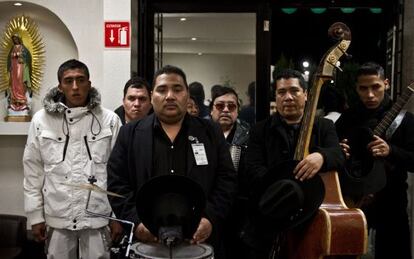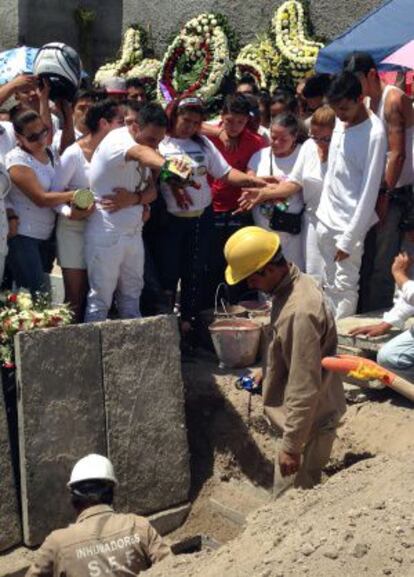Victim’s funeral brings Mexico’s Heavens kidnapping case to symbolic end
As Jerzy Ortiz is laid to rest, motives behind deaths of 13 people abducted from club remain unclear


On the way to the cemetery from Tepito, the girls in the back seat of the minibus hear a motorcycle and turn to look through the back window. The men on the bike had been at the wake. The one riding pillion is holding a beer. As they pass the bus, he makes a face at the passengers. He is dark-skinned and slim as a joint. His face is asymmetrical and now, after a long night of drinking in honor of his childhood friend, the mouth, eyes and nose seem even more out of place. A man with a face worthy of his nickname.
– Look, it’s “El Muerto” – the girls say, laughing.
Moments before, they had been looking at photos of themselves with Jerzy on their phones. One of them was taken on January 6 – the day of the religious holiday celebrating the arrival of the Three Kings to see the newborn Jesus. There are some stuffed elephants in the front row in the picture. Jerzy and Muerto stand side by side behind them. They were 10 years old. But, El Muerto’s eyes look older.
– “They were already calling him El Muerto then,” one of the girls says. “I think he’s been called El Muerto since he was little.”
Jerzy Ortiz was the youngest of the 13 people who were kidnapped in the Heavens after-hours nightclub in downtown Mexico City on May 26, 2013. Mutilated bodies turned up months later in a mass grave in the woods on the outskirts of the city. Jerzy was 16 years old.
Four of the 13 bodies were buried in September. The others have been in the morgue since August. Family members did not trust the authorities and they demanded the opinion of an independent group. A team of Argentinean forensic experts with experience working at home and abroad identified the bodies again earlier this month. Soon after, the families proceeded to bury their dead.
Aged 16, Jerzy Ortiz was the youngest of the 13 kidnapped from a Mexico City club last May
The night before Jerzy’s funeral, his older brother, El Muerto and El Lenguas bring a norteño band to the wake. Juan Carlos Ortiz also has a bottle of Buchanan’s whisky. He is dressed in white. The back of his t-shirt reads, “Tony Montana. Cocaine syndicate” in gold letters.
There is another bottle of Buchanan’s on the casket at the funeral parlor. Someone put a pink ceramic rose on the coffin.
Juan Carlos’ four-year-old daughter is playing with a little Pomeranian dog on the sofa in the room. Her eyes are like electric almonds. The dog, Mailo Versace, belongs to a man who would show up at the cemetery the next day in a Hilfiger sweater and a white beanie worn by Santería practitioners.
At 11pm a pastor begins a sermon. “The Word of God says every knee shall bow down and every tongue shall confess that Jesus will rise. Christ is coming soon. We have seen signs from above. Repent. Repent and seek God tonight.” When the pastor finishes his speech, the band begins to play. The next day, one of Jerzy’s cousins shows everyone at home in Tepito the tattoo on his ribs – a prayer Jerzy published on his Facebook page weeks before his death. “If they have eyes, do not let them see me. If they have hands, do not let them catch me. Do not let me die a violent death. Do not let my blood spill. You who knows everything. You who knows my sins. You who knows the depth of my faith. Do not desert me. Amen.”
“Gordo, you must be kidding,” Juan Carlos says as they lower the casket into the ground. The soil is dry and it peels off under the weight of our feet. His mother asks them to push the casket further back. Juan Carlos is drinking and falling asleep.
El Lenguas, a six-foot-tall man as skinny as El Muerto, tells the gravedigger: “Put my rosary on my buddy here.” El Lenguas is upset. “Put it on him. I want it to look good!” he orders.
The workers place the cement slabs over the casket, ready to seal the grave. Family members drop souvenirs on the coffin. They put down a toy motorcycle because Jerzy liked them. They also give him the bottle of whisky that was on his casket at the funeral parlor. Juan Carlos begins to dump another bottle of Buchanan’s over the entire casket. He takes a swig and then empties the bottle out over the grave.

Before they finish the tombstone, Juan Carlos tells one of the gravediggers, “Wait a minute buddy, you’re scaring him.” El Lenguas and El Muerto are crying. “Don’t shut it, dude,” Juan Carlos says in a faint voice. His mother begs him to stop. “He is not afraid any more, my son. He’s not afraid any more.” Jerzy Ortiz was a 110-pound teenager who slept with the lights on.
Last Thursday, the office of the state attorney general in Mexico City announced the arrest of the alleged mastermind behind the killings. They have already detained 24 suspects. The authorities say the murders were payback for the death of a small-time drug dealer who was killed three days before the kidnappings. Yet, the government also reports that the people captured and killed in the Heavens case neither took part in that crime nor were members of the Tepito Union, the neighborhood crime organization.
It has been suggested that Jerzy’s death was an act of vengeance and that the perpetrators – who belonged to the drug dealer’s gang – decided to kidnap everyone who was partying with the young man that night. His father, Jorge “El Tanque” Ortiz, has been in jail for 10 years. He was an important drug dealer in Tepito. He has said that he is no longer in the business and that his son had nothing to do with it either.
Now rumors say there is a simmering war between Tepito Union and emissaries of the Gulf Cartel, a group from northern Mexico who may have come down to take over the main drug dealing area in the capital. A reporter asked for more information about the situation in Tepito at a press conference but the state attorney’s office did not take questions. The government’s official statement is that, despite the fact that the capital has the highest rate of drug consumption in the entire country, it does not have an organized crime problem. Instead, officials say, Mexico City’s challenge is small-time drug dealing.
As the diggers start to cover the grave with dirt, a 40-year-old man who looked older than his years, one of El Lenguas’ friends, grabs a shovel from one of the workers and begins to do the job himself. A tall thin girl – the one who brought the toy motorcycle – joins him in the task. They finish covering the grave. The group stands in the cloud of dust under the afternoon sun. Suddenly, El Lenguas tells Juan Carlos to go pump the gas pedal of a motorcycle and let the noise of the exhaust pipe be their farewell to Jerzy.
– “Let the motorcycle roar, let it roar!”
The cemetery is built in levels on a hill. Jerzy’s tomb is up high.
Juan Carlos goes down to the parking lot, gets on a racing motorcycle and pumps the gas. A minute of thunder and everyone is clapping. Suddenly, a friend arrives on a scooter, followed by a police car with its flashing light in the back window. A frenzy ensues: the car stops next to the man and the police officer in the passenger seat hits him with the door as he opens it. In no time, both officers are on the man, roughing him up.
Everyone who was at the cemetery runs downhill. As they approach, with El Lenguas in front, one of the officers moves as though to grab his gun. But then, both officers turn around and get in the car. They back out of the parking lot as the crowd slams and kicks the hood of the car.
During the brawl, a young man with a boxer’s muscled neck asks a cameraman from the media crew that had been invited to the burial why he is filming. Without waiting for an answer, he punches him in the head and the reporter hits the ground.
It remains unclear why two plain-clothes police officers chased a man on a scooter in a cemetery.
Translation: Dyane Jean François
Tu suscripción se está usando en otro dispositivo
¿Quieres añadir otro usuario a tu suscripción?
Si continúas leyendo en este dispositivo, no se podrá leer en el otro.
FlechaTu suscripción se está usando en otro dispositivo y solo puedes acceder a EL PAÍS desde un dispositivo a la vez.
Si quieres compartir tu cuenta, cambia tu suscripción a la modalidad Premium, así podrás añadir otro usuario. Cada uno accederá con su propia cuenta de email, lo que os permitirá personalizar vuestra experiencia en EL PAÍS.
En el caso de no saber quién está usando tu cuenta, te recomendamos cambiar tu contraseña aquí.
Si decides continuar compartiendo tu cuenta, este mensaje se mostrará en tu dispositivo y en el de la otra persona que está usando tu cuenta de forma indefinida, afectando a tu experiencia de lectura. Puedes consultar aquí los términos y condiciones de la suscripción digital.








































